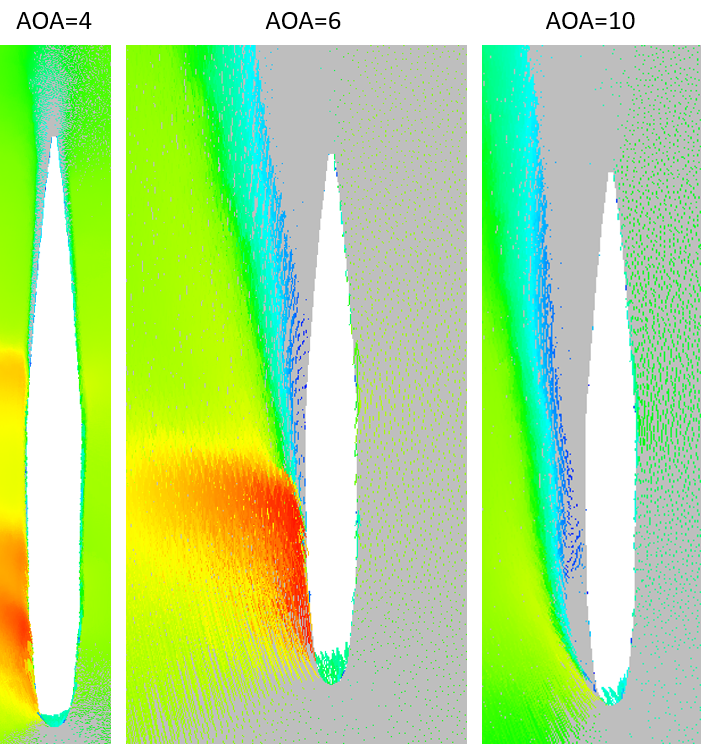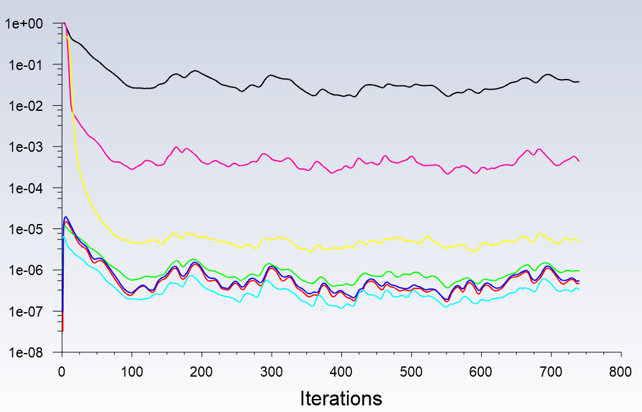TAGGED: ansys-cfd, convergence, flow-separation
-
-
April 8, 2023 at 1:12 pm
goktug.yilmaz
SubscriberHello all,
I am conducting an analysis in Fluent software, focusing on flow separation at different angles of attack, such as 6 and 10 degrees. However, I have noticed that the residual values display fluctuating characteristics and the lift and drag coefficients do not converge to a certain value. I have attached an image showing the velocity vectors at 4, 6, and 10 degrees and residuals at 6 degrees for reference. For 4 degrees, I have converged results because there is nearly no separation. But when it separates, residuals start to oscillate shown in the image below.
To obtain a more accurate analysis, I am seeking guidance on how to approach this issue. I have tried reducing the velocity at 6 degrees to decrease the flow separation and subsequently decrease the residual values, resulting in a slight convergence of the lift and drag coefficients. However, my analysis involves a Mach number around 0.8, and I am currently using the kw-SST method.
I would greatly appreciate any suggestions or solutions that you may have regarding this problem. Thank you in advance for your assistance.
Best regards,
-
April 10, 2023 at 1:45 pm
Federico
Ansys EmployeeI suspect some inherent unsteadiness from the flow separation which prevents the solution to converge to steady-state.
-
April 10, 2023 at 1:55 pm
goktug.yilmaz
SubscriberThanks for your answer. That is what I also suspect. However I do not know how to solve the problem. I tried to reduce time scale from 1 to 0.4, however it does not work.
-
April 10, 2023 at 3:28 pm
Federico
Ansys EmployeeYou can confirm if this is indeed the issue by inspecting where these larger residuals occur in your domain: #2067529 - How can I post-process my residuals to better understand convergence issues ? (ansys.com).
If the solution cannot converge in steady-state, you might need to switch to transient simulation.
-
April 11, 2023 at 10:03 am
Rob
Forum ModeratorTo add, put some monitor points into the domain in regions of interest and look at (for example) velocity fluctuations on those points. Plot wall shear stress on the upper & lower wing surfaces every few iterations too. Then review the results to see what's changing, and by how much.
-
- The topic ‘Residual fluctuations and inconsistent lift and drag coefficients in Fluent’ is closed to new replies.


- air flow in and out of computer case
- Varying Bond model parameters to mimic soil particle cohesion/stiction
- Eroded Mass due to Erosion of Soil Particles by Fluids
- I am doing a corona simulation. But particles are not spreading.
- Guidance needed for Conjugate Heat Transfer Analysis for a 3s3p Li-ion Battery
- Centrifugal Fan Analysis for Determination of Characteristic Curve
- Issue to compile a UDF in ANSYS Fluent
- JACOBI Convergence Issue in ANSYS AQWA
- affinity not set
- Resuming SAG Mill Simulation with New Particle Batch in Rocky

-
3882
-
1414
-
1241
-
1118
-
1015

© 2025 Copyright ANSYS, Inc. All rights reserved.









